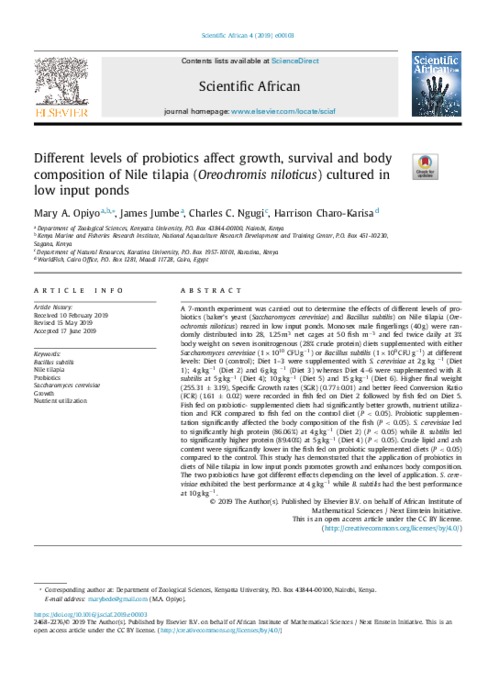Please use this identifier to cite or link to this item:
https://hdl.handle.net/20.500.12348/3932
Different levels of probiotics affect growth, survival and body composition of Nile tilapia (Oreochromis niloticus) cultured in low input ponds
| dc.creator | Opiyo, M.A. | en_US |
| dc.creator | Jumbe, J. | en_US |
| dc.creator | Ngugi, C.C. | en_US |
| dc.creator | Karisa, H.C. | en_US |
| dc.date.accessioned | 2020-03-11T08:49:14Z | |
| dc.date.available | 2020-03-11T08:49:14Z | |
| dc.date.issued | 2019 | en_US |
| dc.identifier.citation | Mary Opiyo, James Jumbe, Charles Ngugi, Harrison Karisa. (4/7/2019). Different levels of probiotics affect growth, survival and body composition of Nile tilapia (Oreochromis niloticus) cultured in low input ponds. Scientific African, 4. | en_US |
| dc.identifier.issn | 2468-2276 | en_US |
| dc.identifier.uri | https://hdl.handle.net/20.500.12348/3932 | |
| dc.description.abstract | A 7-month experiment was carried out to determine the effects of different levels of probiotics (baker's yeast (Saccharomyces cerevisiae) and Bacillus subtilis) on Nile tilapia (Oreochromis niloticus) reared in low input ponds. Monosex male fingerlings (40 g) were randomly distributed into 28, 1.25 m3 net cages at 50 fish m−3 and fed twice daily at 3% body weight on seven isonitrogenous (28% crude protein) diets supplemented with either Saccharomyces cerevisiae (1 × 1010 CFU g−1) or Bacillus subtilis (1 × 109 CFU g−1) at different levels: Diet 0 (control); Diet 1–3 were supplemented with S. cerevisiae at 2 g kg −1 (Diet 1); 4 g kg−1 (Diet 2) and 6 g kg −1 (Diet 3) whereas Diet 4–6 were supplemented with B. subtilis at 5 g kg−1 (Diet 4); 10 g kg−1 (Diet 5) and 15 g kg−1 (Diet 6). Higher final weight (255.31 ± 3.19), Specific Growth rates (SGR) (0.77±0.01) and better Feed Conversion Ratio (FCR) (1.61 ± 0.02) were recorded in fish fed on Diet 2 followed by fish fed on Diet 5. Fish fed on probiotic- supplemented diets had significantly better growth, nutrient utilization and FCR compared to fish fed on the control diet (P < 0.05). Probiotic supplementation significantly affected the body composition of the fish (P < 0.05). S. cerevisiae led to significantly high protein (86.06%) at 4 g kg−1 (Diet 2) (P < 0.05) while B. subtilis led to significantly higher protein (89.40%) at 5 g kg−1 (Diet 4) (P < 0.05). Crude lipid and ash content were significantly lower in the fish fed on probiotic supplemented diets (P < 0.05) compared to the control. This study has demonstrated that the application of probiotics in diets of Nile tilapia in low input ponds promotes growth and enhances body composition. The two probiotics have got different effects depending on the level of application. S. cerevisiae exhibited the best performance at 4 g kg−1 while B. subtilis had the best performance at 10 g kg−1. | en_US |
| dc.format | en_US | |
| dc.language | en | en_US |
| dc.publisher | Elsevier B.V. | en_US |
| dc.rights | CC-BY-4.0 | en_US |
| dc.source | Scientific African;4,(2019) | en_US |
| dc.subject | Fish | en_US |
| dc.title | Different levels of probiotics affect growth, survival and body composition of Nile tilapia (Oreochromis niloticus) cultured in low input ponds | en_US |
| dc.type | Journal Article | en_US |
| cg.contributor.crp | Fish | en_US |
| cg.contributor.funder | CGIAR System Organization | en_US |
| cg.coverage.region | Global | en_US |
| cg.subject.agrovoc | growth | en_US |
| cg.subject.agrovoc | probiotics | en_US |
| cg.subject.agrovoc | nutrient utilization | en_US |
| cg.subject.agrovoc | nile tilapia | en_US |
| cg.subject.agrovoc | bacillus subtilis | en_US |
| cg.subject.agrovoc | saccharomyces cerevisiae | en_US |
| cg.contributor.affiliation | Wageningen University & Research Centre | en_US |
| cg.contributor.affiliation | WorldFish | en_US |
| cg.contributor.affiliation | Kenyatta University | en_US |
| cg.contributor.affiliation | Karatina University | en_US |
| cg.identifier.status | Open access | en_US |
| cg.contribution.worldfishauthor | Karisa, H.C. | en_US |
| cg.description.theme | Sustainable aquaculture | en_US |
| dc.identifier.doi | https://dx.doi.org/10.1016/j.sciaf.2019.e00103 | en_US |
| cg.creator.id | Harrison Charo Karisa: 0000-0001-5323-794X | en_US |
Files in this item
This item appears in the following Collection(s)
-
Sustainable aquaculture [2717]
